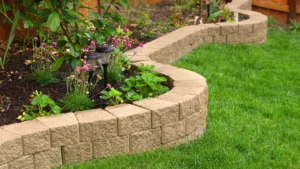
Does your garden feel a bit unfinished, like it’s missing something to tie it all together? The answer could be as simple as the right hardscape feature. It’s not easy creating outdoor spaces that effortlessly balance beauty with practicality, often because the non-living elements haven’t been properly considered.
Speaking of non-living elements, this refers to hardscaping. Hardscaping in garden landscaping relates to the use of materials like stone, wood, concrete, brick, and gravel to create structures like footpaths, patios, and fences.
Unlike softscaping (the living elements such as plants, soil, and turf), hardscaping provides your garden structure, giving it definition, usability, and year-round visual appeal. In this guide, we’ll explore the benefits of hardscaping, the types of features you can incorporate, key design considerations, and how to maintain these elements for lasting beauty.
With the right hardscaping, you can transform a garden from a collection of plants into a cohesive, functional outdoor room. Consider features like retaining walls, patios, and pathways that carve out distinct zones and create visual interest even in winter.
But it’s not just about looks. Garden hardscaping dramatically increases outdoor functionality by giving you usable spaces for entertaining, dining, or relaxing. A well-placed patio becomes an extension of your home, while walkways guide movement and protect your lawn.
There’s also a practical advantage in that hardscaping requires far less maintenance than planting areas. Plus, quality hardscaping boosts your property value while improving drainage and erosion control when designed correctly.
Now that you understand the benefits, let’s explore the hardscaping features that can transform your outdoor space. After all, the beauty of garden hardscaping lies in its versatility, with options to suit every style and budget.
The material you choose matters as much as the feature itself. Each brings its own character, maintenance requirements, and longevity to your landscape design.
Here’s where thoughtful landscape design becomes essential for creating hardscaping that truly enhances your outdoor space. The most successful projects balance functionality with aesthetics, creating features that work beautifully while serving a clear purpose.
Start by considering scale and proportion. A tiny patio in a sprawling garden looks lost, while oversized paving can overwhelm a compact courtyard. Your hardscaping should feel right for the space it occupies.
Material choices need to complement your property’s architectural style. Contemporary homes pair beautifully with sleek porcelain pavers, whereas period cottages suit reclaimed brick or natural stone.
Drainage planning can’t be an afterthought. Poor drainage leads to pooling water and slippery surfaces. Working with professionals like Bonsai Landscapes helps you avoid costly mistakes.
The magic happens when hardscaping in garden landscaping works in perfect partnership with your planting. This integration between rigid structures and organic forms creates gardens that feel complete, balanced, and visually engaging throughout the seasons.
Think of softscaping and hardscaping as two sides of the same coin. Hard surfaces provide the structure, while plants bring softness, colour, and seasonal interest. A stone path bordered by flowing perennials feels natural and inviting, while a timber deck surrounded by native shrubs blurs the line between built and natural environments.
Pay special attention to transition points where paving meets planting beds. These junctions can be softened with trailing plants or decorative gravel.
Hardscaping’s greatest strength is its year-round presence, maintaining visual interest even when borders lie dormant in winter.
Quality hardscaping reduces overall garden maintenance, but it’s not entirely maintenance-free. A little regular care is required to keep your hard surfaces looking smart and functioning properly for decades.
Here’s what to include in your maintenance routine:
Even with this checklist, hardscaping demands far less attention than replanting and lawn care.
Thinking about adding structure and functionality to your garden? Our team at Bonsai Landscapes specialises in hardscaping in garden landscaping, assisting customers across Poole, Bournemouth, Christchurch, and the surrounding Dorset areas.
Whether you’re dreaming of a new patio, stylish stone walkway, or a complete low-maintenance garden layout, we’ll help bring your vision to life.
With our local expertise and fully insured, professional service, you’ll avoid costly mistakes and create outdoor spaces that truly enhance your property. To get started, call us on 07477 968735 or 07407 063683. Alternatively, complete our contact form to discuss your project or learn more about our services.
We’d love to help you design a garden that balances beauty with practicality.
Recent Posts
2025 © Bonsai Landscapes